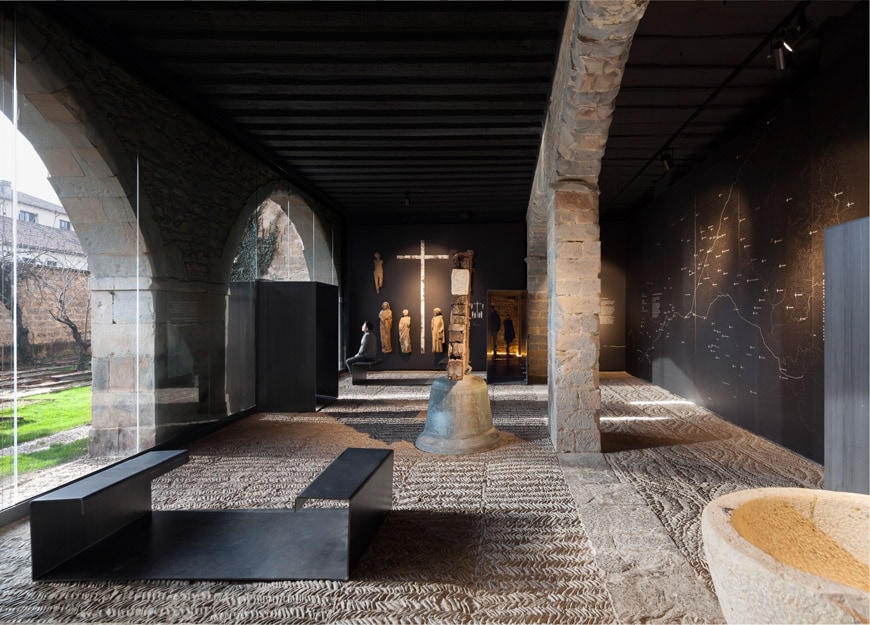Occidens is a history museum, part of the outstanding architectural complex of the Pamplona Cathedral.
The museum depicts the long history of the Pamplona Cathedral site as a metaphor for the history of Western countries. Designed by Spanish architects Vaillo+Irigaray, the museum features a fascinating contrast between its contemporary design and the architectural structures that accommodate it, dating from the 2nd century B.C. to the 19th century AD.
Multimedia installations and exquisite antique artworks coexist in the same rooms creating an intriguing relationship that brings the museum’s visitors on a captivating journey across time and space.
Pamplona Cathedral
The Pamplona Cathedral’s complex is one of the most important examples of religious architecture in Northern Spain. Located in the Navarre region, Pamplona has always been an important Catholic religious center, also due to its being positioned on the Way of Saint James pilgrimage route (Camino de Santiago in Spanish).
The Cathedral complex consists today of a Gothic-style church (though with a late-18th century Neoclassic facade) built between 1394 and 1501, a 13th-century cloister, and other Romanesque and Gothic buildings. Nevertheless, recent excavations have revealed the remains of preexisting buildings dating back to the 2nd century B.C., and of the medieval Romanesque church the current Cathedral replaced in the 15th century.
Pamplona Cathedral, exterior views; copyright Vaillo + Irigaray – photos Ruben Perez Bescos
Occidens Museum – text by Vaillo + Irigaray architects
OCCIDENS is not an exhibition; it’s a reflection about the West.
West is neither civilization nor geography, but a mental territory.
Occidens museum takes place in the Pamplona cathedral complex, (II c bC – XIX c aC), crossing various spaces of different times: archaeological excavations II c bC-VIII c, Romanesque palace XI c, Archbishop’s Palace XII c, and the Gothic constructions of the Archdeacon palace of the XIV-XVI c.
Occidens Museum, Pamplona Cathedral, interior view and floor plans
Narrative project and visitor’s experience
The Museum is conceived as a narrative project closer to a cinematographic discipline than to the conventional schemes of the museum through a discourse deployed through different frames and different reading levels: signs, images, objects, sounds, text, projections, codes, smells, and atmospheres …
The project enhances the relationship between content-continent, and between architecture and art by devising different atmospheres appropriate to each time and each space.
Occidens Museum, Pamplona Cathedral, permanent exhibition, installation views
Steel carpet – guiding thread
The unity of the museum – composed of architectures of different times- is achieved by using a carpet of steel that meanders through the various rooms of millenarian architectures floating between archaic atmospheres without touching the footprints of the past, giving unity to the whole exhibition. A single resource, flexible and ambivalent, is able to realize its potential to generate an iconography able to provide homogeneity to an uneven set in time and space.
A black steel plate 1cm thick is bent and drilled to become a gangway, pavement, bench, lamp, or exhibitor the drilled texts explain while lighting, guiding, and giving content to the travel.
Occidens Museum / Pamplona Cathedral, Architectural and exhibition design:
VAILLO + IRIGARAY Architects – Antonio Vaíllo, Juan L. Irigaray, Daniel Galar, Josecho Vélaz
Museum concept: Javier Aizpún
Occidens Museum, Pamplona Cathedral, permanent exhibition, installation views
All images courtesy of Vaillo + Irigaray (http://www.vailloirigaray.com) – photos Ruben Perez Bescos
